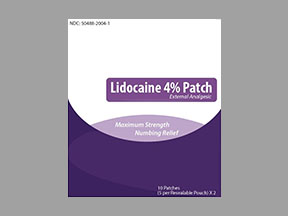
Eq Lidocaine Pain Relieving Coupons & Savings Card – Discount Prices from $22.03
Brand for: Lidocaine
My prescription
Edit
4%, Lidocaine (30 Patches)
Select pharmacy

Walgreens
$22.03
COUPON PRICE
Albertsons
$26.56
COUPON PRICE
Walmart
$41.35
COUPON PRICEEq Lidocaine Pain Relieving savings card
Show this card to your pharmacist
Walgreens
$22.03
BIN
ID
PCN
GRP
015995
LHEX074886
GDC
GDRX
Powered by
More prescriptions for postherpetic neuralgia
More prescriptions for postherpetic neuralgia
Eq Lidocaine Pain Relieving (Lidocaine) dosage forms
Dosage Quantity Price from Per unit 4% 30 Patches $37.23 $1.24 4% 1 Patch $9.94 $9.94 4% 10 Patches $18.41 $1.84 4% 15 Patches $23.12 $1.54
| Dosage | Quantity | Price from | Per unit |
|---|---|---|---|
| 4% | 30 Patches | $37.23 | $1.24 |
| 4% | 1 Patch | $9.94 | $9.94 |
| 4% | 10 Patches | $18.41 | $1.84 |
| 4% | 15 Patches | $23.12 | $1.54 |
Eq Lidocaine Pain Relieving Warnings
Eq Lidocaine Pain Relieving Side Effects
Lidocaine is a widely used local anesthetic that effectively numbs specific areas to relieve pain. While generally safe when used as directed, it's important to be aware of potential side effects, which can vary depending on the form of lidocaine used—such as topical applications, injections, or patches. Common Side Effects:
- At the Application Site: Users may experience temporary redness, swelling, burning, or irritation where lidocaine is applied. These effects typically subside within a few minutes to hours.
- Systemic Effects: Some individuals might encounter dizziness, drowsiness, or a mild headache. These symptoms are usually short-lived and resolve without intervention.
Serious Side Effects: Although rare, more severe reactions can occur:
- Allergic Reactions: Signs include rash, itching, swelling (especially of the face, tongue, or throat), severe dizziness, or difficulty breathing. Immediate medical attention is necessary if these symptoms arise.
- Central Nervous System Effects: Overuse or improper application can lead to confusion, nervousness, tremors, blurred vision, or even seizures.
- Cardiovascular Issues: In some cases, irregular heartbeats, chest pain, or low blood pressure may occur.
Precautions: To minimize risks:
- Proper Application: Avoid applying lidocaine to large areas or broken skin, and do not use it under tight bandages or with heat, as this can increase absorption and potential toxicity.
- Medical History: Inform your healthcare provider of any existing conditions, especially heart, liver, or respiratory issues, before using lidocaine.
- Pregnancy and Breastfeeding: Consult a healthcare professional before use, as lidocaine can cross into breast milk.
When to Seek Medical Help: If you experience severe side effects, such as difficulty breathing, chest pain, severe dizziness, or signs of an allergic reaction, seek immediate medical attention. Understanding these potential side effects and taking appropriate precautions can help ensure the safe and effective use of lidocaine for pain relief.
Eq Lidocaine Pain Relieving Interactions
When using Lidocaine for pain relief, it's important to be aware of potential interactions with other medications, as these can affect its safety and effectiveness. Here are some key considerations:
Other Local Anesthetics: Combining lidocaine with other local anesthetics can lead to additive toxic effects. If such combinations are necessary, patients should be closely monitored for signs of neurological and cardiovascular issues.
Monoamine Oxidase Inhibitors (MAOIs) and Tricyclic Antidepressants: Using lidocaine with Epinephrine in patients taking MAOIs or tricyclic antidepressants may result in severe, prolonged high blood pressure. Concurrent use is generally discouraged; if unavoidable, careful monitoring of the patient's blood pressure is essential.
Ergot-Type Oxytocic Drugs: Combining lidocaine with epinephrine and ergot-type oxytocic drugs can cause severe, persistent high blood pressure or cerebrovascular accidents. Such combinations should be avoided.
Nonselective Beta-Adrenergic Antagonists (Beta-Blockers): Administering lidocaine with epinephrine to patients on nonselective beta-blockers may lead to severe high blood pressure and slow heart rate. Concurrent use should generally be avoided; if necessary, monitor blood pressure and heart rate closely.
Drugs Associated with Methemoglobinemia: Certain medications can increase the risk of methemoglobinemia when used with local anesthetics like lidocaine. These include nitrates/nitrites (e.g., Nitroglycerin), other local anesthetics (e.g., Benzocaine), antineoplastic agents (e.g., Cyclophosphamide), antibiotics (e.g., Dapsone), antimalarials (e.g., chloroquine), anticonvulsants (e.g., Phenytoin), and other drugs like Acetaminophen.
Potent Inhalation Anesthetics: Using lidocaine with epinephrine during or after administration of potent inhalation anesthetics may cause serious, dose-related irregular heart rhythms.
Phenothiazines and Butyrophenones: These medications may reduce or reverse the blood pressure-raising effect of epinephrine. Concurrent use with lidocaine and epinephrine should generally be avoided; if necessary, careful patient monitoring is essential.
Beta-Blockers and Cimetidine: Drugs like Propranolol (a beta-blocker) and cimetidine can reduce the clearance of lidocaine from the body, potentially leading to toxic accumulation. Caution is advised when these drugs are used together.
Class III Antiarrhythmic Drugs: Patients treated with class III antiarrhythmic drugs (e.g., Amiodarone) should be under close surveillance and may require ECG monitoring, as cardiac effects may be additive.
Diuretics: Diuretics can antagonize the action of lidocaine due to the potential for causing low potassium levels (hypokalemia).
CYP1A2 Substrates: Lidocaine, as a potent inhibitor of CYP1A2, can reduce the metabolism of other drugs that are substrates of this enzyme, potentially leading to increased effects or side effects of those drugs.
Epilepsy: If the dose or site of administration is likely to result in high blood levels, lidocaine should be used with caution in patients with epilepsy, who will require special attention to prevent potentially dangerous side effects.
Atazanavir: Co-administration of lidocaine with atazanavir increases the risk of cardiotoxicity and arrhythmias.
Cimetidine: Drugs that reduce the clearance of lidocaine (e.g., cimetidine) may cause potentially toxic plasma concentrations when lidocaine is given in repeated high doses over a long time period.
Darunavir: Darunavir may increase lidocaine levels in blood serum.
Quinupristine: Co-administration of lidocaine with quinupristine increases the risk of toxicity.
Tamoxifen: Lidocaine may reduce the therapeutic effect of tamoxifen by reducing the production of its active metabolites.
Telithromycin: Telithromycin may reduce the clearance of lidocaine.
Terbinafine: Terbinafine may reduce the metabolism and clearance of lidocaine.
Voriconazole: Voriconazole may increase lidocaine levels in blood serum by reducing its metabolism.
Atrioventricular Block: If the dose or site of administration is likely to result in high blood levels, lidocaine should be used with caution in patients with atrioventricular block, who will require special attention to prevent potentially dangerous side effects.
Endotracheal Tube: Lidocaine should not be used on cuffs of endotracheal tubes (ETT) made of plastic. Lidocaine base in contact with both PVC and non-PVC cuffs of endotracheal tubes may cause damage of the cuff. This damage is described as pinholes, which may cause leakage that could lead to pressure loss in the cuff.
Porphyria: Lidocaine is probably porphyrinogenic and should only be prescribed to patients with acute porphyria on strong or urgent indications. Appropriate precautions should be taken for all porphyric patients.
Cardiovascular Disease, Heart Failure: If the dose or site of administration is likely to result in high blood levels, lidocaine should be used with caution in patients with cardiovascular disease and heart failure, who will require special attention to prevent potentially dangerous side effects.
Alcohol: Alcohol consumption with lidocaine may increase the risk of low blood pressure and cause adverse effects such as dizziness, fainting, light-headedness, or headache.
Breastfeeding: Lidocaine use in breastfeeding patients is not recommended.
Pregnancy: Lidocaine falls under Pregnancy Category C, indicating that animal reproduction studies have not been conducted, and it is not known whether it can cause fetal harm when administered to a pregnant woman. It should be given to a pregnant woman only if clearly needed.
Food: Using tobacco may interfere with the action of lidocaine and, as a result, may alter the effectiveness of the drug.
Cannabidiol: Monitor for lidocaine toxicity if coadministration with cannabidiol is necessary, as concurrent use may increase lidocaine exposure.
Capmatinib: Monitor for lidocaine toxicity if coadministration with capmatinib is necessary, as concurrent use may increase lidocaine exposure.
Capreomycin: Lidocaine could potentiate the neuromuscular blocking effect of capreomycin by impairing transmission of impulses at the motor nerve terminals.
Captopril: Antihypertensives, including angiotensin-converting enzyme inhibitors, antagonize the vasopressor effects of parenteral epinephrine.
Carbamazepine: Concomitant use of systemic lidocaine and carbamazepine may decrease lidocaine plasma concentrations.
Carbidopa; Levodopa; Entacapone: Use COMT inhibitors and epinephrine together with caution due to potential for increased heart rate, arrhythmias, and excessive changes in blood pressure.
Cardiac Glycosides: Carefully monitor patients receiving cardiac glycosides and vasopressors concurrently due to the increased risk of arrhythmia.
Carteolol: Drugs such as beta-blockers that decrease cardiac output reduce hepatic blood flow and thereby decrease lidocaine hepatic clearance.
Carvedilol: Drugs such as beta-blockers that decrease cardiac output reduce hepatic blood flow and thereby decrease lidocaine hepatic clearance.
Ceritinib: Monitor for lidocaine toxicity if coadministration with ceritinib is necessary.
Cetirizine; Pseudoephedrine: Pseudoephedrine can potentiate the effects and increase the toxicity of other sympathomimetics by adding to their sympathomimetic activity.
Elvitegravir; Cobicistat; Emtricitabine; Tenofovir Alafenamide: Monitor for lidocaine-related adverse reactions if coadministration with cobicistat is necessary.
Elvitegravir; Cobicistat; Emtricitabine; Tenofovir Disoproxil Fumarate: Monitor for lidocaine-related adverse reactions if coadministration with cobicistat is necessary.
Enzalutamide: Monitor for decreased efficacy of lidocaine if coadministration of systemic lidocaine with enzalutamide is necessary; higher doses of lidocaine may be required.
Epinephrine: Monitor patients who receive epinephrine while concomitantly taking antiarrhythmics for the development of arrhythmias.
Eslicarbazepine: Concomitant use of systemic lidocaine and eslicarbazepine may decrease lidocaine plasma concentrations.
Esmolol: Drugs such as beta-blockers that decrease cardiac output reduce hepatic blood flow and thereby decrease lidocaine hepatic clearance.
Ethotoin: Lidocaine is a substrate for the cytochrome P450 isoenzymes 1A2 and 3A4. Ethotoin may enhance lidocaine clearance by inducing cytochrome P
Can lidocaine be used as a painkiller?
Yes, lidocaine can be used as a painkiller. It is a local anesthetic that works by numbing specific areas of the body to relieve pain. It is commonly used in various forms, such as topical creams, patches, or injections, to manage pain from minor injuries, procedures, or conditions like neuropathic pain.
Does lidocaine have narcotics in it?
Lidocaine does not contain narcotics. It is a local anesthetic used to numb tissue in a specific area and does not have the properties of narcotic drugs.
Using the SaveHealth discount card, what is the price of Eq Lidocaine Pain Relieving without insurance?
Using the SaveHealth discount card, the price of Eq Lidocaine Pain Relieving without insurance is $22.03.
What is the price of Eq Lidocaine Pain Relieving at Walgreens?
The price of Eq Lidocaine Pain Relieving at Walgreens is $22.03.
What is the price of Eq Lidocaine Pain Relieving at Walmart?
The price of Eq Lidocaine Pain Relieving at Walmart is $41.35.
